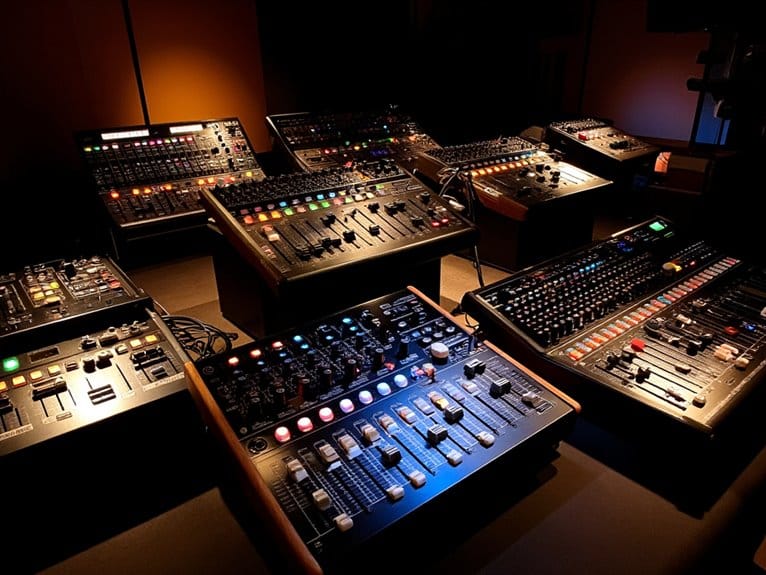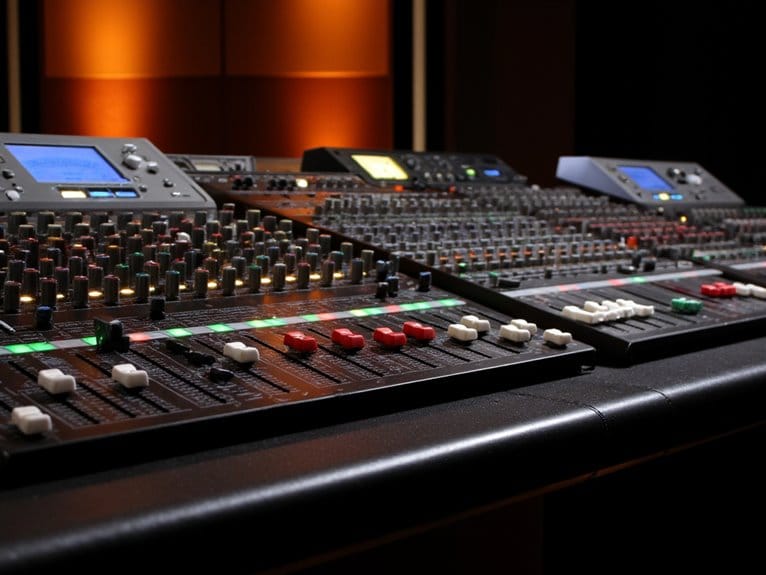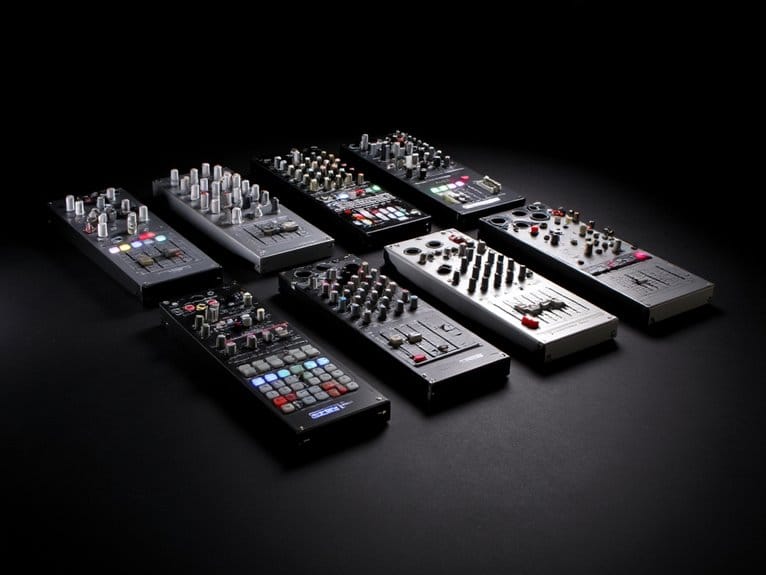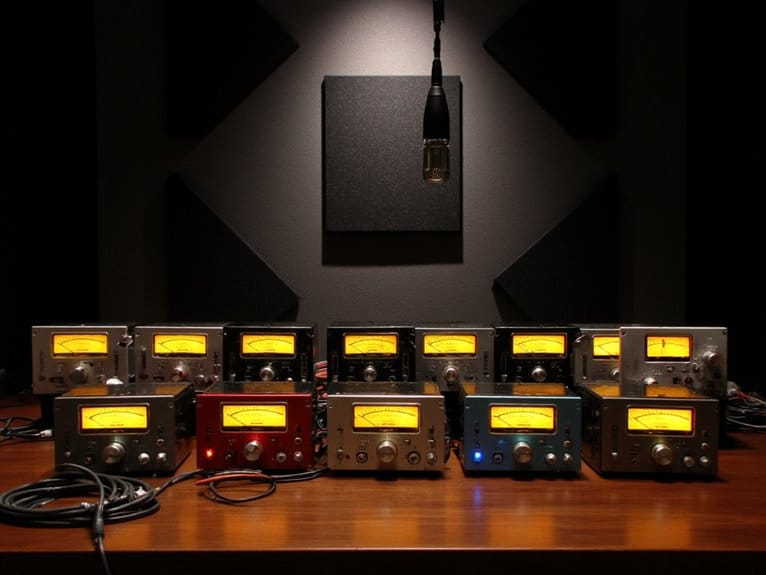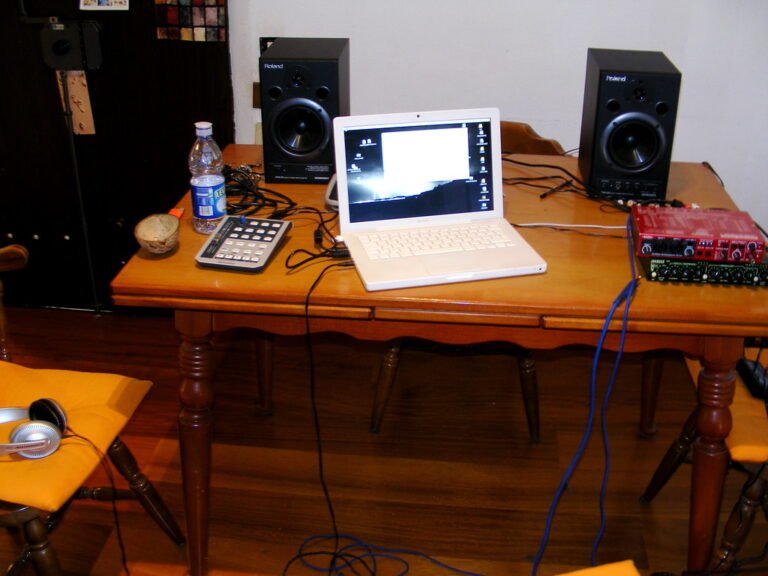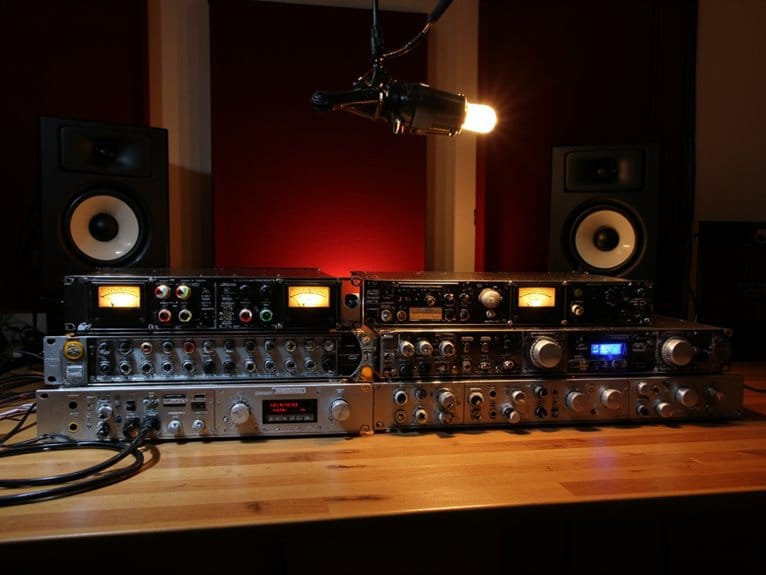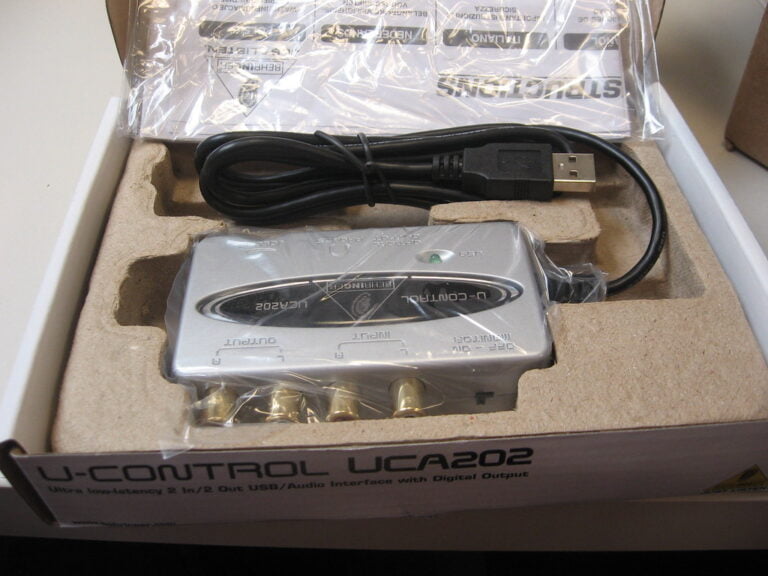10 Best Mixers for Streaming That Will Level Up Your Audio Game
After testing dozens of streaming mixers, I’ve found that the TC-Helicon GoXLR delivers professional-grade audio control with studio-quality preamps and real-time vocal effects, while budget-conscious streamers should consider the FIFINE AmpliGame SC3, which offers twelve auto-tune options and six voice-changing modes with essential XLR connectivity. The YAMAHA MG10XU provides exceptional sound quality for serious content creators, and the RØDE RØDECaster Duo excels for podcast-focused streaming with its intuitive interface, though each mixer’s channel count, operating system compatibility, and feature set will determine your ideal choice for elevating broadcast quality beyond typical amateur setups.
We are supported by our audience. When you purchase through links on our site, we may earn an affiliate commission, at no extra cost for you. Learn more.
Notable Insights
- Look for mixers with XLR inputs, USB connectivity, phantom power, and low-noise preamps for professional-quality streaming audio.
- Choose mixers offering real-time voice effects, customizable sound pads, and multiple input channels to enhance viewer engagement.
- Budget-friendly options like FIFINE AmpliGame SC3 and Pyle PMXU63BT provide essential streaming features at affordable prices.
- Prioritize plug-and-play compatibility with streaming platforms like OBS, Discord, and Twitch for seamless integration and setup.
- Consider build quality and operating system support, as some premium mixers work only with Windows systems.
FIFINE Gaming Audio Mixer with XLR Microphone Interface (AmpliGame SC3)

After testing dozens of streaming mixers over the past few years, I’ve found that the FIFINE AmpliGame SC3 stands out as an exceptional entry point for new content creators who want professional XLR microphone support without breaking the bank. You’ll get four individual channel controls, built-in 48V phantom power for condenser mics, and surprisingly robust sound effects including twelve auto-tune options and six voice-changing modes. The RGB lighting adds visual flair without overwhelming your setup, while the plug-and-play compatibility with both Windows and Mac means you won’t struggle with complex installation procedures that sometimes plague budget mixers.
Best For: New content creators and streamers who want to upgrade to XLR microphones without spending heavily on professional mixing equipment.
Pros:
- Built-in 48V phantom power and XLR input provide professional microphone support at an entry-level price point
- Comprehensive sound effects with 12 auto-tune options and 6 voice-changing modes for creative streaming content
- Plug-and-play compatibility with Windows and Mac eliminates complex setup procedures
Cons:
- Primarily plastic construction may feel less durable compared to higher-end mixers
- Lacks modern features like Bluetooth connectivity and sidechain support
- Not compatible with USB microphones, limiting flexibility for users with existing USB mic setups
Pyle 6-Channel Professional Audio Mixer (PMXU63BT)

When you’re seeking a budget-friendly mixer that doesn’t compromise on essential streaming features, the Pyle 6-Channel Professional Audio Mixer (PMXU63BT) delivers impressive versatility through its combination of USB connectivity, Bluetooth wireless streaming, and 48V phantom power capability. You’ll appreciate the rugged steel chassis with sealed rotary controls that resist dust and grime, while the multi-voltage power supply guarantees consistent performance worldwide. The mixer supports XLR and unbalanced 1/4″ inputs with 3-band EQ on all channels, plus LED peak level indicators for monitoring. I’ve found the wireless streaming from mobile devices particularly convenient for content creators who need flexible audio sources during broadcasts.
Best For: Budget-conscious content creators, live performers, and karaoke enthusiasts who need a versatile mixer with wireless streaming capabilities and professional features like phantom power.
Pros:
- Combines USB, Bluetooth, and 48V phantom power in an affordable package with worldwide voltage compatibility
- Rugged steel chassis with sealed rotary controls provides durability against dust and environmental factors
- Wireless streaming from mobile devices offers convenient audio source flexibility for live performances and content creation
Cons:
- Limited to 6 channels which may be restrictive for larger live sound applications or complex recording setups
- Budget-tier construction may not offer the same audio quality and reliability as higher-end professional mixers
- Compact design likely means fewer advanced features and routing options compared to full-sized mixing consoles
PUPGSIS Gaming Audio Mixer for PC/Podcast/Streaming with Voice Changer

The PUPGSIS Gaming Audio Mixer stands out as an ideal choice for content creators who need professional audio quality without breaking the bank, particularly those seeking versatility in voice modulation and multi-platform streaming capabilities. You’ll appreciate the six voice-changing modes and customizable soundpads, which let you experiment with different sounds while triggering effects that enhance your creative output. The intuitive four-fader interface controls Mic 1, Mic 2/headset, Aux/Bluetooth, and Line Out channels, making operations straightforward with a helpful display showing current volume levels. Zero latency monitoring prevents audio delays, while the one-touch mute function saves you from live streaming mishaps that we’ve all experienced at some point.
Best For: Content creators, podcasters, and streamers who need professional audio quality with voice modulation features and multi-platform compatibility at an affordable price point.
Pros:
- Six voice-changing modes and customizable soundpads provide creative flexibility for streaming and content creation
- Intuitive four-fader interface with volume display makes operation straightforward for users of all skill levels
- Zero latency monitoring and one-touch mute function prevent audio delays and live streaming mishaps
Cons:
- Limited to basic reverb presets which may not satisfy users seeking advanced audio processing options
- Four-channel mixing capability may be insufficient for larger podcast or streaming setups requiring more inputs
- Budget-oriented design may lack the build quality and durability of higher-end professional audio equipment
Podcast Microphone Bundle with Live Sound Card Audio Mixer

Content creators who demand professional audio quality without the steep learning curve will find this Podcast Microphone Bundle with Live Sound Card Audio Mixer particularly compelling, since it combines a 3.5mm condenser microphone, boom arm, and detailed sound board into one plug-and-play solution. You’ll appreciate the built-in noise reduction technology alongside customizable voice controls, including adjustable bass, treble, reverb, and pitch settings that transform amateur recordings into polished content. The sound board supports both 3.5mm and 6.35mm dynamic microphones, while offering twelve built-in effects like applause and laughter, plus seven reverb modes for versatile audio enhancement across different streaming scenarios.
Best For: Content creators, podcasters, gamers, and streamers who want professional audio quality with beginner-friendly plug-and-play setup and comprehensive sound mixing capabilities.
Pros:
- Complete all-in-one bundle with condenser microphone, boom arm, and advanced sound board featuring 12 built-in effects and customizable voice controls
- Built-in noise reduction technology and multiple reverb modes (7 total) deliver professional audio quality for live streaming and recording
- User-friendly plug-and-play design works seamlessly with PC, Mac, and mobile devices without requiring technical expertise
Cons:
- Some users have reported reliability issues with the volume control knob functionality
- Limited to 3.5mm and 6.35mm microphone compatibility, which may restrict upgrade options for some users
- At 4.3/5 stars with mixed feedback, audio quality performance may not consistently meet expectations for all users
TC-Helicon GoXLR Online Broadcaster Platform with 4-Channel Mixer

Broadcasting enthusiasts who demand professional-grade audio control will find the TC-Helicon GoXLR Online Broadcaster Platform represents a significant leap beyond basic streaming mixers, combining motorized faders, studio-quality preamps, and real-time vocal effects into a thorough 4-channel solution. You’ll appreciate the MIDAS preamp’s phantom power capability for XLR microphones, while the built-in equalizer, compressor, and de-esser provide broadcast-quality processing that I’ve found essential for polished streams. The sampler functionality lets you record clips on-the-fly, and voice effects like pitch shift and hard tune add entertainment value, though you’ll need Windows since there’s no Linux or macOS support.
Best For: Content creators, streamers, and podcasters who need professional-grade audio mixing capabilities with real-time vocal effects and multi-source audio control for Windows-based broadcasting setups.
Pros:
- Studio-quality MIDAS preamp with comprehensive audio processing including equalizer, compressor, limiter, de-esser, and phantom power for XLR microphones
- Motorized faders provide tactile control over multiple audio sources (mic, game, music, chat) with real-time voice effects like pitch shift and reverb
- Built-in sampler allows on-the-fly recording and audio file importing to enhance audience engagement during broadcasts
Cons:
- Limited to Windows operating systems only with no support for Linux or macOS users
- Requires the GoXLR Windows app for full functionality, creating software dependency for operation
- Higher price point compared to basic streaming mixers due to professional-grade features and motorized components
Behringer FLOW 8 8-Input Digital USB Audio Mixer with Bluetooth

Streamers seeking professional-grade audio control without the complexity of traditional mixing consoles will find the Behringer FLOW 8 an intriguing bridge between analog simplicity and digital versatility. You’ll appreciate its compact 3-pound footprint, wireless Bluetooth control through the FLOW app, and two Midas microphone preamps with 48V phantom power that deliver surprisingly clean audio for its price point. The EZ-GAIN function automatically optimizes levels, while 60mm faders provide tactile control that feels reassuring during live streams. However, you should expect some Bluetooth latency issues that can affect audio-video synchronization, and the micro USB connector feels somewhat fragile for frequent use.
Best For: Streamers, mobile DJs, and small venue performers who want professional-grade audio control with wireless capabilities but don’t need the complexity of traditional analog mixing consoles.
Pros:
- Compact 3-pound design with wireless Bluetooth control via FLOW app and two high-quality Midas microphone preamps with 48V phantom power
- EZ-GAIN function automatically optimizes audio levels while 60mm faders provide tactile control for live performance situations
- Fully configurable outputs with individual equalizers and limiters, plus preset saving capabilities for different audio environments
Cons:
- Bluetooth audio input creates latency issues that negatively affect audio-video synchronization during streaming
- Micro USB connector feels fragile and may not withstand frequent plugging and unplugging over time
- Built-in vocal effects are unsatisfactory and lack sufficient customization options for professional applications
FIFINE Gaming Audio Mixer with XLR Microphone Interface (AmpliGame SC3)

New content creators often find themselves caught between wanting professional-grade audio quality and working within tight budget constraints, which is exactly where the FIFINE Gaming Audio Mixer with XLR Microphone Interface (AmpliGame SC3) positions itself as an attractive entry point. The SC3 delivers XLR microphone capabilities with 48V phantom power for condenser mics, four individual channel controls with volume faders, and twelve auto-tune options that’ll either enhance your voice or make you sound like a robot having an existential crisis. Its RGB lighting adds visual flair without overwhelming brightness, while the plug-and-play compatibility guarantees you won’t spend hours troubleshooting connectivity issues.
Best For: New content creators and podcasters who want to upgrade from USB mics to XLR setups without breaking the bank, especially those who enjoy experimenting with voice effects and want RGB lighting for their streaming setup.
Pros:
- Cost-effective entry point into XLR mixing with 48V phantom power for condenser microphones
- Intuitive four-channel control layout with easily accessible mute and monitor buttons for real-time audio management
- Fun customizable features including voice changing modes, auto-tune options, and adjustable RGB lighting for streaming aesthetics
Cons:
- Plastic construction feels less durable compared to higher-end mixers in the same category
- Missing modern features like Bluetooth connectivity and sidechain support that advanced users may expect
- Limited to basic functionality that may require upgrades as content creation needs become more sophisticated
YAMAHA MG10XU 10-Input Stereo Mixer with Effects

When you’re juggling multiple audio sources during live streams, the YAMAHA MG10XU‘s ten-input capacity with built-in USB connectivity makes it an exceptional choice for content creators who’ve outgrown basic two-channel setups but aren’t ready to invest in expensive broadcast equipment. You’ll appreciate the D-PRE discrete Class A preamps and onboard SPX digital effects, which deliver professional-grade sound quality that’s earned this mixer a 4.6-star rating from nearly 4,000 users. While the top-mounted outputs might feel awkward during setup, the three-band EQ, one-knob compressors, and phantom power functionality provide everything you need for polished streaming audio at a reasonable price point.
Best For: Content creators and live streamers who need professional audio quality with multiple input sources but want an affordable, user-friendly mixer that bridges the gap between basic equipment and expensive broadcast gear.
Pros:
- Professional D-PRE discrete Class A preamps and onboard SPX digital effects deliver exceptional sound quality with low noise levels (-128 dBu equivalent input noise)
- Versatile connectivity with 10 inputs, USB integration for DAW workflows, XLR inputs, and comprehensive controls including 3-band EQ and one-knob compressors
- Robust build quality with impact-resistant metal chassis and excellent value proposition, earning 4.6 stars from nearly 4,000 users
Cons:
- Limited to stereo output which may restrict flexibility for larger or more complex audio setups
- Top-mounted outputs create awkward cable management and can be inconvenient during setup and operation
- May require upgrading to higher channel count mixers or dedicated audio interfaces for users needing multi-track recording capabilities
RØDE RØDECaster Duo All-in-One Production Solution for Podcasting & Streaming

RØDE’s RØDECaster Duo positions itself as the Swiss Army knife of content creation, targeting podcasters and streamers who demand professional-grade audio without the complexity of traditional mixing boards. You’ll appreciate its compact design housing two Neutrik combo jacks, ultra-low-noise Revolution Preamps delivering -131.5dBV EIN with 76dB gain, and four broadcast-quality faders complemented by a responsive touchscreen interface. The integrated Series IV 2.4GHz receiver seamlessly connects RØDE wireless microphones, while six programmable SMART pads handle routing tasks that typically require menu diving. However, some users experience OBS connectivity challenges and streaming latency issues, suggesting this excels more in podcast production than live streaming applications.
Best For: Podcasters and content creators who need professional-grade audio quality with an intuitive interface but primarily focus on recording rather than live streaming applications.
Pros:
- Ultra-low-noise Revolution Preamps (-131.5dBV EIN, 76dB gain) deliver pristine, professional audio quality
- Intuitive design with programmable SMART pads, broadcast-quality faders, and haptic touchscreen simplifies complex routing tasks
- Comprehensive connectivity including integrated wireless receiver, Bluetooth, dual USB-C, Wi-Fi, and multiple recording options
Cons:
- OBS connectivity challenges and latency issues limit effectiveness for live streaming applications
- Higher price point compared to basic podcast recording solutions
- Learning curve required to fully utilize advanced features and customization options
Factors to Consider When Choosing a Mixer for Streaming
When I’m selecting a streaming mixer, I consider five critical factors that’ll determine whether your setup enhances or hinders your content creation. The audio input options and channel count requirements form the foundation of your decision, since you’ll need adequate XLR inputs for microphones, USB connectivity for computers, and sufficient channels to accommodate your current setup plus future expansion plans. Sound quality standards, voice effects features, and overall connectivity compatibility with your existing equipment will ultimately dictate how professional your streams sound and how seamlessly your mixer integrates into your workflow.
Audio Input Options
Before diving into specific mixer models, I need to emphasize that audio input options represent the foundation of your streaming setup, determining which devices you can connect and how flexibly you can configure your audio sources. When evaluating mixers, I focus on XLR ports for professional microphones, line inputs for instruments, and modern connectivity like USB and Bluetooth integration. Phantom power becomes essential if you’re using condenser microphones, eliminating the need for separate power supplies. I particularly value mixers that accommodate multiple simultaneous sources-microphones, instruments, and auxiliary devices-because this versatility transforms your streaming capabilities. Additionally, built-in effects and voice changing features can elevate your content, though I’d consider these bonus features rather than necessities for most streamers.
Channel Count Requirements
Channel selection represents perhaps the most critical decision you’ll make when choosing a streaming mixer, as it directly determines your content creation flexibility and room for growth. I’ve found that four channels work well for basic setups with one or two microphones plus background music, but you’ll quickly outgrow this configuration if you’re ambitious. Six or more channels provide breathing room for multiple microphones, sound effects, and separate audio sources, which I consider essential for serious streamers. While more channels mean increased complexity and steeper learning curves, I’d rather have unused channels than hit limitations mid-stream. Planning ahead prevents the frustration of realizing you’ve boxed yourself into a restrictive setup.
Sound Quality Standards
Exceptional sound quality separates amateur streams from professional broadcasts, and I’ve learned that preamp performance makes the biggest difference in your audio clarity. When evaluating mixers, I focus on high-gain, low-noise preamps with specifications like -131.5 dBV EIN, which capture crystal-clear audio without unwanted hiss or interference. Phantom power capability remains essential for condenser microphones, which consistently outperform dynamic mics in controlled streaming environments. I also examine input and output noise ratings, seeking mixers with -128 dBu input noise and -102 dBu output noise for ideal performance. Digital signal processing features, including built-in equalizers and real-time effects, allow for immediate sound adjustments during broadcasts. Quality construction minimizes electrical interference, ensuring consistent audio fidelity throughout extended streaming sessions.
Connectivity and Compatibility
Three essential connectivity features determine whether your mixer will integrate seamlessly into your streaming setup, and I’ve discovered that USB connectivity stands as the most critical foundation for modern broadcast workflows. I always prioritize mixers with multiple input types-XLR for professional microphones, LINE IN for instruments, and AUX for auxiliary devices-because this flexibility prevents frustrating compatibility issues during live sessions. Platform compatibility matters greatly, particularly with OBS and Discord, which dominate the streaming landscape. I’ve learned that checking software integration beforehand saves countless headaches later. Bluetooth connectivity adds wireless convenience for mobile device streaming, reducing cable clutter while maintaining audio quality. For collaborative content, I verify the mixer supports simultaneous connections for multiple microphones or instruments, enabling smooth multi-person broadcasts without technical complications.
Voice Effects Features
Beyond hardware connections, voice effects features transform your mixer from a simple audio routing device into a creative powerhouse that can dramatically enhance your streaming persona. I’ve found that pitch shifting, reverb, and echo capabilities allow real-time vocal manipulation, creating distinct character voices or atmospheric effects that keep audiences engaged. Customizable sound buttons prove invaluable for triggering pre-defined effects instantly, adding spontaneous entertainment value without fumbling through software menus. Advanced mixers offering multiple voice-changing modes enable experimentation with different vocal styles, whether you’re creating comedic content or establishing a unique streaming identity. The vital factor here is real-time processing with minimal latency, ensuring you hear effects immediately without awkward delays that disrupt natural conversation flow during live broadcasts.
Build Quality Durability
When investing hundreds of dollars in streaming equipment, I’ve learned that build quality directly impacts both your immediate user experience and long-term return on investment, making durability assessments essential before committing to any mixer purchase. I always prioritize mixers with metal chassis construction over plastic alternatives, as they provide superior resistance to wear and tear during frequent adjustments and transport. The quality of individual components matters considerably-faders and knobs should feel solid under your fingers, not wobbly or cheap. I’ve found that sealed rotary controls offer excellent protection against dust accumulation and moisture exposure, which can destroy sensitive electronics over time. Professional-grade mixers typically incorporate rugged features designed for stage performances, ensuring they’ll handle your streaming setup’s daily demands without compromising functionality.
Budget and Value
While durability guarantees your mixer survives years of consistent use, establishing a realistic budget framework helps you identify which features truly matter for your streaming goals without overspending on unnecessary capabilities. I’ve found that entry-level mixers ranging from $50 to several hundred dollars offer varying value propositions, so I focus on features like multiple input channels, built-in effects, and phantom power that justify the investment. Customer ratings reveal which products deliver reliable performance relative to their price point, helping me avoid disappointing purchases. I also consider long-term viability by examining upgrade potential and software compatibility. Don’t forget additional costs for cables and stands, which can greatly impact your overall budget allocation.
Streaming Platform Integration
Since streaming success depends heavily on seamless software compatibility, I’ve learned that choosing a mixer with robust platform integration can make or break your broadcasting experience. The best streaming mixers offer native support for OBS, Discord, Twitch, and YouTube, eliminating the frustrating technical hiccups that can derail live broadcasts. I prioritize mixers with plug-and-play functionality across Windows and Mac systems, though I’ve noticed some models still favor certain operating systems over others. Essential features include customizable sound pads for instant effects, multiple microphone inputs for guest collaborations, and mobile device connectivity that transforms tablets into remote control interfaces. This flexibility proves invaluable when managing complex streaming setups, allowing real-time audio adjustments without interrupting your content flow or audience engagement.
Frequently Asked Questions
Do I Need a Mixer if I Only Stream Occasionally?
I don’t think you need a mixer for occasional streaming. Your computer’s built-in audio or a simple USB microphone will work fine. Mixers are better investments for regular streamers who want professional control.
Can I Use Any Headphones With Streaming Mixers?
I’ll recommend checking your mixer’s headphone output first. Most streaming mixers work with standard headphones using 3.5mm or 1/4-inch jacks. You might need an adapter for different connector types.
How Do I Prevent Audio Delay When Using a Mixer?
I’ll minimize audio delay by using ASIO drivers, reducing buffer sizes in my streaming software, connecting via USB 3.0 or higher, and keeping my mixer’s firmware updated for ideal latency performance.
What’s the Difference Between Analog and Digital Mixers for Streaming?
I’ll explain the key differences between analog and digital mixers for your streaming setup. Analog mixers use physical circuits and offer tactile control, while digital mixers process audio through software with more features.
Do Streaming Mixers Work With All Streaming Software Platforms?
I’ve found that most streaming mixers work with popular platforms like OBS, Streamlabs, and XSplit through USB or audio interface connections. You’ll want to check compatibility requirements for your specific software beforehand.
On a final note
I’ve tested countless mixers over the years, and these options represent the best balance of features, reliability, and value for streamers. Whether you’re starting with the budget-friendly FIFINE SC3 or investing in the professional-grade RØDECaster Duo, each mixer addresses specific streaming needs. Consider your current setup, growth plans, and budget when choosing-the right mixer will transform your audio quality and elevate your streaming presence considerably.

